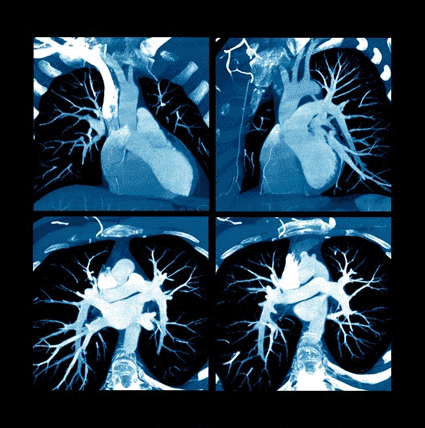Radiation Risk Tied to CT Scans May Be Overstated
By HospiMedica staff writers
Posted on 20 Dec 2007
Posted on 20 Dec 2007

Image: Colored computed tomography (CT) scan of the healthy heart of a 23 year-old with coronal views at the top, and axial views at the bottom (Photo courtesy of Zephyr / SPL).
The American College of Radiology (ACR; Reston, VA, USA) is concerned that specific conclusions and comparisons made in the study, "Computed Tomography--An Increasing Source of Radiation Exposure,” published in the November 29, 2007, issue of the New England Journal of Medicine (NEJM), may be inappropriate and cause patients to mistakenly avoid receiving life-saving medical imaging care.
The study claimed that up to 2% of all cancers in the United States might be caused by radiation received from CT scans. However, the study authors admit that there are currently no published studies directly linking CT scans (even multiple CT scans) to cancer.
The study also equates radiation exposure and effects experienced by many atomic bomb survivors in Japan to present day patients who receive CT scans. Most CT exams are performed in a controlled setting. They result in limited radiation exposure to a small portion of the body. Atomic bomb survivors experienced instantaneous radiation exposure to the whole body. Moreover, CT exams expose patients solely to X-rays. Atomic blast survivors were exposed to X-rays, particulate radiations, neutrons, and other radioactive materials. The known biologic effects are very different for these two scenarios.
There is little doubt in the medical community that CT scans help save lives. Recent technologic developments increasingly allowed imaging exams to replace more invasive techniques, but also resulted in an increased radiation exposure for patients.
The College urged patients and providers to visit the "Radiology Safety” section of the ACR Website as well as the "Radiation Safety” section of the Radiology Info Website, the patient information site co-managed by the ACR and the Radiological Society of North America (RSNA; Oakbrook, IL, USA), for more information regarding radiation exposure from medical imaging exams.
Patients should also keep a record of their X-ray history and before undergoing a scan, should ask their physician: (1) Why do I need this exam? (2) How will having this exam improve my health care? (3) Are there equally good alternatives that do not use radiation? (e.g., MRI, ultrasound, etc.). (4) Is this facility ACR accredited? (This ensures that physician and staff meet education and training standards and that equipment is surveyed regularly by medical physicist to ensure that it is functioning properly.)
The ACR has led the effort to eliminate unnecessary radiation dose in imaging for decades. Historic ACR actions to monitor and reduce radiation dose include:
1. ACR Appropriateness Criteria (1993) that help radiologists and referring physicians prescribe the most appropriate imaging exam for more than 200 clinical conditions (which can help patients avoid unnecessary exposure to scans utilizing radiation when other imaging modalities such as MRI and ultrasound that do not use radiation, may be better for that particular condition).
2. Accreditation of facilities that offer X-ray technologies (including dose assessments) for mammography (1987), stereotactic breast biopsy (1996), and CT (2002).
3. Practice Guidelines and Technical Standards (1990), which layout the acceptable protocols for performing imaging exams (including CT).
ACR activities to lower radiation dose were recently summarized in the ACR Whitepaper on Radiation Dose in Medicine published in May 2007. In that article, the ACR Blue Ribbon Panel on Radiation Dose also outlined 33 specific action items to help reduce radiation dose. The following items are already in motion: 1) Creation of a Dose Registry (2008) including CT dose and the ability to establish benchmarks. 2) Working with other medical specialties on radiation dose awareness. An example of this is the upcoming "Consensus Conference on Imaging Safety and Quality for Children in the Emergency Setting” scheduled for Feb. 2008 (cosponsored by the Society for Pediatric Radiology).
The ACR reported that it would continue to work with congress, government agencies, other medical specialties, and public and private payers to improve quality and reduce unnecessary radiation exposure for patients.
Related Links:
American College of Radiology
Radiology info














